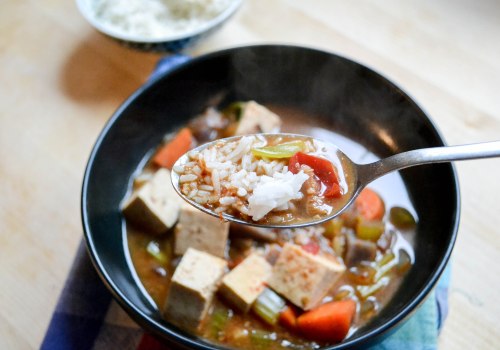
Hey, this is also vegan, warming, spicy and all kinds of cool stuff!
Doenjang jigae (된장찌개) is a common Korean dish made with fermented bean paste (‘doenjang’ which is similar to Japanese miso). In addition to the doenjang, much of the flavor comes from dried anchovies but I don’t eat those anymore so I had to come up with something else. This may not be to everyone’s taste–the earthy salty aroma of the fermented bean paste may be unusual to some. If you like miso soup and vegetables, you will like this.
A word about doenjang, the fermented bean paste: It’s nutritious. A word to those who avoid spice: You are missing out on so much great food. Please work on this. Little by little, you can build your spice muscle. It’s good for your soul, I promise.
This recipe is inspired by the magnificent maangchi blog–my favorite food blog these days. If you are not vegetarian and want to cook the traditional recipe with dried anchovies and shrimp, here is her youtube video. The vegetarianization is all my own. I made the stock with kelp, dried mushrooms, garlic and a little vegetable boullion. I also added in carrots and celery, which is not traditional.
This Korean stew can be eaten with salad and barley rice or on its own.
Ingredients for vegetarian doenjang jigae
serves 2-3 people
6 spring onions, chopped
1 cup of good quality vegetable stock
1 hand-sized piece of kombu, or dried kelp
Handful dried mushrooms (optional)
Handful shiitake mushrooms
2 fat garlic cloves, smashed and sliced
1 tbs shoyu organic soy sauce
1 small onion or 1/2 large onion, cut into large chunks
1 heaping tbs of Korean bean paste (doenjang)
1 tsp go chu gar u (Korean chili powder)
1 potato, peeled and cubed
1/2 zucchini, cubed (or other vegetable)
mix of other vegetables, such as carrot, celery, green beans (optional, not traditional)
1/2 block of firm tofu, cubed
1 chopped green chili, such as serrano or jalapeno (leave the seeds in if you want extra spice)
salt and pepper
water, as needed (about 1 cup)
Go chu jang (a Korean chili paste) for serving
You will have to go to a Korean market for the doenjang and the gochujang. Often, they have it written in English and Korean. Doenjang usually comes in a brown container:

Gochujang is in a red container. This is a great condiment to have anyway and can be used just like you would use sriracha sauce. It is great with sticky rice, kim (Korean dried seaweed) and vegetables, in a stir fry, in soups, with lettuce and bulgogi (if you are a carnivore) etc.

1) To make a salty broth (without dried anchovies), bring a cup of vegetable stock to boil in a deep wok or medium pot.
2) Add in the dried mushrooms, minced garlic, soy sauce and kombu. Turn the heat down and simmer for 10-15 minutes. Remove the dried kelp.
3) Now that you have your soup base ready, add in the shitake mushrooms, potato, onion, zucchini (I used carrots and green beans), green chili and chili powder.
4) Add cold water to just cover the vegetables and mix in the doenjang soybean paste.

5) Simmer the stew until the vegetables are tender. Add in the cubed tofu and spring onions and gently cook a few more minutes.
Very good on a cold winter’s day.
If you would like to serve with rice and salad, see recipes below.
I did not make barley rice, as I had leftover sticky rice to use up. If you want to try it, here is a simple recipe:
Brown rice and barley
1 cup brown short grain rice
1/4 cup pearl barley
2 cups of water
1) Rinse the rice and barley
2) Bring everything to a boil in a medium pot
3) Turn heat down and simmer covered on very low until cooked, about 40 minutes.
A simple salad
Mix of lettuce and greens, such as red leaf lettuce and mixed chard
2 spring onion, chopped
1/2 large cucumber, diced
2 tsp soy sauce
1/2 tsp sugar
pinch of red chili flakes
1 tsp toasted sesame oil
sprinkling of roasted sesame seeds
1) Add the vegetables together in a large bowl.
2) Mix the soy sauce, sugar, red chili flakes and sesame oil in a small dish to make the dressing.
3) Mix all together and sprinkle over the roasted sesame seeds.
The soup, barley rice and salad can be eaten as three separate dishes, or all mixed together as the Maangchi blog suggests. Don’t forget to add the gochujang to your bowl–as much as you like!



